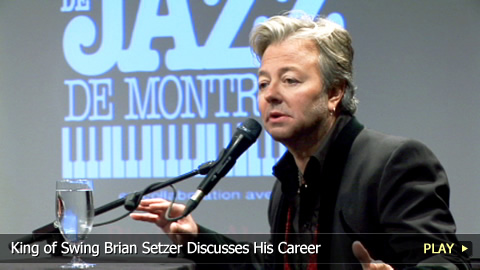King of Swing Brian Setzer Discusses His Career

Early Years and Influences
Born April 10th, 1959 in Massapequa, New York, Brian Setzer was interested in music from a young age, and started out playing brass horns before switching to guitar.
Brian Setzer: “I started playing guitar when I was 8-years-old. My parents were broke: they found a guy in the yellow pages and he really took his time and showed me how to play guitar and read and write music. And then I was really influenced by these bands like the Allman Brothers and Creedence Clearwater Revival. One day I was listening to a Beatles record and my dad started singing along with ‘Honey Don’t,’ and then I realized that all the early Beatles and Stones records were rockabilly songs. So that’s how I really got my vision of what I was.”
The Stray Cats
Once his musical influences were set by the end of the 1970s, Setzer formed a rockabilly revival band. The Stray Cats lineup was solidified by 1979, with Setzer being joined by Lee Rocker and Slim Jim Phantom. The trio then set out to stimulate interest in their chosen genre and the music of the 1950s.
Brian Setzer: “I don’t think about reviving musical styles. I love the sounds of music that comes from the blues. I love jazz; I love country, swing, rock and roll, rockabilly. My way of thinking is: why can’t you take all these kinds of music and blend them together? I never consciously thought of blending them.”
Move to the UK
They gained a following in the New York scene; however it was their move to the United Kingdom that really solidified the Stray Cats as a success.
Brian Setzer: “I love the Stray Cats because the boys in the band are my brothers. I would like to tour the States with them; we’re just very popular in Europe.”
Stray Cats are a Hit
Just three months after moving to England in the summer of 1980, the band had a record contract. Their breakthrough album was 1982’s Built for Speed, and it made them popular in Europe as well as in the U.S. This record featured the hit “Rock This Town,” and that song has since been listed as one of the most important songs in rock history. They followed that up with “Stray Cat Strut,” and these singles exemplified their punk-infused jazz rock style.
Stray Cat Split
In 1984, the band broke up. It was also around this time that Setzer began performing with former Led Zeppelin front man Robert Plant in his R&B-inspired rock band The Honeydrippers.
Solo Career and Reunion with the Cats
By 1986, Setzer had struck out on his own and released a mildly successful solo album. Even so, The Stray Cats reunited that year and managed to stay together until the early 1990s before parting ways, only to reunite again for a Farewell Tour in the 2000s.
La Bamba and Eddie Cochran
In 1987, Setzer was able to pay homage to his idol Eddie Cochran by portraying him in the film La Bamba.
Brian Setzer: “Eddie Cochran. He’s my biggest inspiration, when I saw a picture of him I said, ‘I want to look like that guy,’ then when I heard his music, ‘I want to pattern myself after this guy.’ I wanted to sound like him and look like him and it evolved from there.”
The Brian Setzer Orchestra
By 1992, Setzer had founded the blues and swing band the Brian Setzer Orchestra.
Brian Setzer: “I always do things in extremes: going from a 3-piece to 18-piece to sometimes playing alone. I always play the same style of guitar and one day I had the idea to have a big band behind the Stray Cats. Why wouldn’t this work? It’s true that big band is much more jazz-oriented, so when those guys are playing those chords you’ve got to be aware of what’s going past you. It’s still me.”
Bringing Back Jive
The instrument ensemble was an ambitious project, and the band’s popularity grew primarily due to its energetic live show. The Orchestra’s biggest mainstream hit came in 1998 with their cover of “Jump, Jive an’ Wail,” and that song won Setzer one of his three Grammy awards.
Brian Setzer: “I knew it was something musically that had not been done before. There had not been a guitar leading a big band. The big band era died and rock and roll was born, so the two never got to meet.”
Solo Work and The Simpsons
Throughout his time with the Brian Setzer Orchestra, the front man continued to release solo records. In 2002, he joined several members of rock royalty on an episode of The Simpsons, mentoring Homer while at rock and roll fantasy camp.
Brian Setzer: “We’ll start with the fundamentals: playing a burning guitar with your teeth.”
Unique Musician, Unique Look
Setzer is almost as recognizable for his look as he is for his music. His bouffant blond pompadour and 50s-style clothing is a throwback to the original rockabilly days.
The King of Swing
He is recognized as the man who brought two dying musical genres back to popularity, and that’s why Brian Setzer is known as the King of Swing.
Brian Setzer: “Most big bands don’t approach it from the guitar point of view, and the guitar leads the orchestra so it’s gonna rock ‘cause that’s what I do.”
